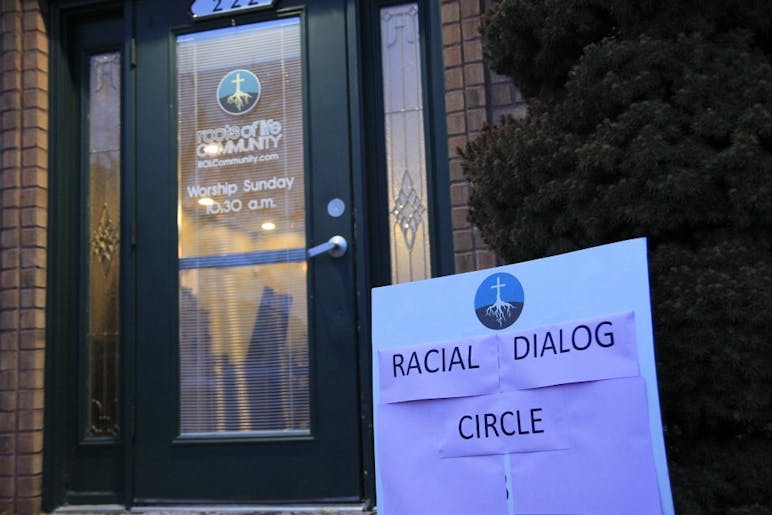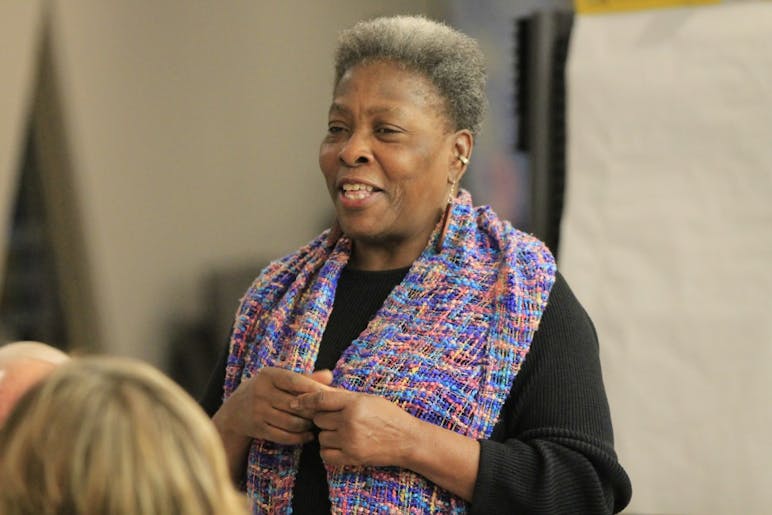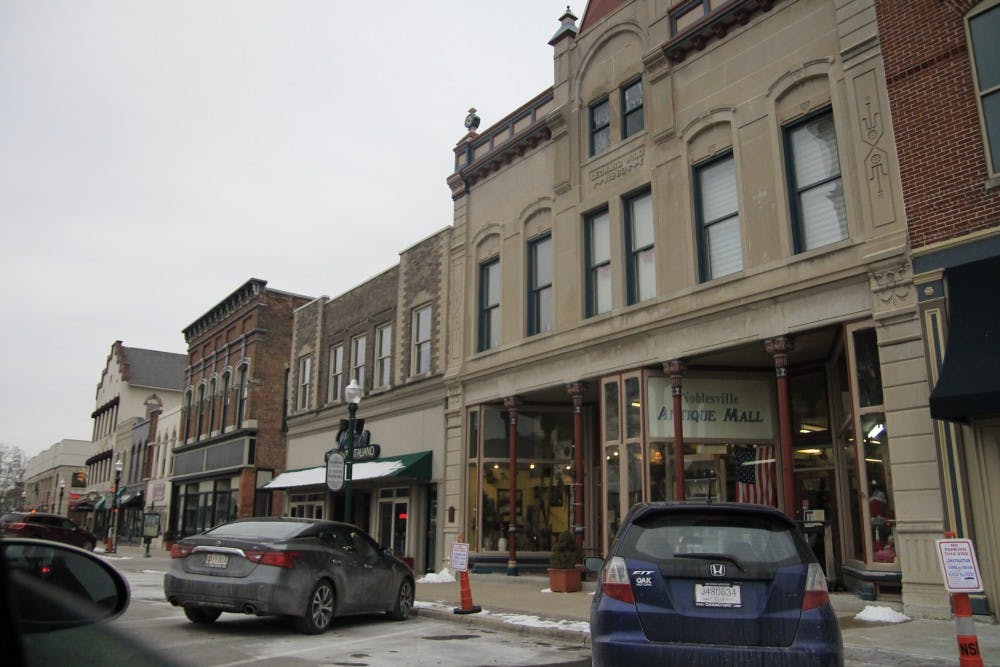NOBLESVILLE, Ind. — When Connie Blanford’s teenage son mentioned something in passing about the video of the kid with the Nazi flag, she thought he must have been talking about some video he saw at school. Some bit of viral news she missed. Not something that happened in her city.
She knew her home, a city of about 60,000 northeast of Indianapolis, wasn’t free of the racism that seemed more present in America by the day. Her son, Nathan, is African-American, and he had told her about experiences with racism she may have otherwise never noticed: how a football teammate he’d played with since first grade called him the N-word; how a customer at the carwash where he worked clutched her purse when one of his black coworkers approached her; how, as he walked down the street one day, a white woman crossed to avoid him.
Still, she found herself thinking, "That wouldn’t happen here."
Online, that night, she found out it had. The day before Martin Luther King Jr. Day, a Snapchat video had leaked onto social media. It shows a teenager draped in a Nazi flag and yelling racial slurs into a megaphone.
Over the next two weeks, ripples spread. Twitter users identified the teen in the video as a Noblesville High School student named Mat Blood and called for action from the school. Indianapolis media outlets reported on the story. In one broadcast, Blood offered an apology.
The story found its way to bigger media, including the Root, Raw Story and the UK’s Daily Mirror. A rumor spread, possibly from within a private Facebook group for parents of NHS students, that Blood had committed suicide. The high school’s principal condemned Blood's actions but also chastised the vitriol of parents in a note that sparked more controversy.
The principal’s statement suggested the incident could constitute a teachable moment, an opportunity for a conversation about race in this 90-percent-white community. But would the people of Noblesville confront the hate in their midst? Overtly racist incidents had come and gone before. Most people — maybe because they considered them non-issues, or because talking about race made them uncomfortable, or because they feared shining a bad light on their town — seemed to want to forget.
“Part of the issue with racism in Noblesville,” Blanford said, “is that nobody thinks it exists.”
* * *
In the video, Blood wears black clothes, a cap pulled low on his head and the flag on his back. In the first second, he shouts a racial slur through the bullhorn. In the second, someone behind the camera starts talking.
“Turn around,” the voice says. “Let me see your flag.”
He does. The flag shows an eagle with a swastika in its talons. The image is similar to the Parteiadler, the emblem of the Nazi Party in the 1930s and 40s. Three other people stand around him. After nine seconds, the video cuts off.
Two days later, on Indianapolis’s WRTV, Blood said he’d shamed his family and lamented that the video might hamper his chances of getting into the Army. He said he’d worn the flag and yelled the slurs as part of a dare. Blood and his family did not respond to interview requests from the Indiana Daily Student.
The first wave of news had already prompted social media users and online-news commenters to blast Blood. Though some defended him under the banner of free speech or the folly of youth, others said he was pathetic, that he should be expelled, that people like him need to be stopped,that he only regretted his behavior because he got caught.
“This is not a good kid,” one Facebook commenter and Noblesville resident said on WRTV’s post.
Then, over the next week, rumor of Blood’s suicide spread. Jeff Bryant, the high school’s principal, debunked it, chastised parents for “publicly bashing this 17-year-old child” and encouraged them to use it as an opportunity to have serious conversations with their children.
Bryant’s statement rekindled the controversy, as some lauded his measured approach and others suggested the statement made light of Blood’s actions. Noblesville Schools declined an IDS request to make Bryant available for an interview.
To Teri Ditslear, a local Lutheran pastor and the wife of Noblesville Mayor John Ditslear, watching the news unfold felt like being “on some darn roller coaster.” The video frustrated and disgusted her, she said, but it didn’t surprise her. She knew racism existed in Noblesville, even if people in her circles pretended it didn’t.
“Where does this kid get these ideas?” she wondered. “Somebody has to be blamed, but it’s probably a whole bunch of things.”
Nor did it shock Shakeera Edmond, an African-American parent of a kindergartner. She moved to Noblesville two years ago for her job in the mental health sector, and she felt as if the video highlighted a division within the city.
People outside Noblesville could perceive that division, too, she said. Her Indianapolis friends wouldn’t consider living in the area because of its lack of diversity.
“It’s not because minorities aren’t here — it’s something else,” she said. “Certain issues aren’t talked about. They’re just ignored.”
Blood’s flag-bearing didn’t happen in a vacuum. American white nationalist, white supremacist and so-called alt-right groups have grown in size and prominence since the 2016 presidential election.
Racist sentiments have continued to make news across Indiana, even in cities considered more liberal than the rest of the state. On Feb. 1, a Ku Klux Klan affiliate left fliers around Indianapolis’ Monument Circle. A week later, in Bloomington, an IU student came under fire after a racist Snapchat post.
But in January, the video of Blood was just Noblesville’s latest racially charged news appearance. In 2016, Klan fliers appeared in the front yards of houses in Noblesville and nearby Fishers. The year before, a Noblesville property owner put up a large sign, visible from the street, that declared Mexican people “do not belong in the U.S.” In 2010, a local shop owner made the news for selling soap with packaging featuring racist caricatures.
Last September, concerned about the racial climate at home and nationwide, Teri Ditslear invited 50 religious leaders from across the county to a “lunch and learn” about racial awareness. Only three people said they’d attend.
One person showed up.
* * *

One early sign suggested the long-term response to the Mat Blood incident might look different.
On Jan. 27, a racial awareness course called Racial Dialogue Circles had an informational meeting at a church in Fishers. For the course, volunteers would gather for a series of frank discussions about race, with the goal that they create a plan to better their communities.
The meeting had been planned before the Blood video went viral, said Richard Bellaver, one of the organizers of the circles. But the timing resulted in a strong turnout, with appearances by city and school officials.
One of the circles decided to meet in Noblesville two weeks later for the first of the course’s five discussions. So, on a Thursday night in early February, a dozen people gathered in a low brick building, a five-minute drive from the park where Blood had worn the Nazi flag.
The building housed Roots of Life Community, the church where Teri Ditslear pastors. The group was about half white people, half people of color. Some came from Noblesville, others from elsewhere in Hamilton County. They ranged from young educators to gray-haired retirees.
The conversation largely avoided the viral video. A pair of teachers from Hamilton Southeastern Schools, one white and one African-American, wanted to encourage their students to have a voice. Noblesville’s director of economic development hated having to tell outsiders that the city lacked diversity. A black Noblesville police officer wanted his sons to be unafraid to talk about racism.
Co-organizer Gustanna Moss Chaney, who is African-American, has done diversity and racial awareness work for two decades. It can be difficult, she said. But every time she thinks of stepping away, the thought that people are more powerful together than separated pulls her back.
“What frightens you about being here?” Chaney asked after the group had outlined its hopes and expectations. “What makes you uncomfortable?”
She held a marker and stood at a board in front of the table with large sheets of paper attached to it. The marker squeaked as she wrote.
“It seems like we’re preaching to the choir a little bit,” said Victor Cortez, who grew up in the Philippines and moved to the United States as a teenager in the 1980s. “It’s multiple perspectives, but we’re on the same side.”
Many of them had found it difficult to even start a measured discussion about race.
They mentioned friends, coworkers or family who wouldn’t listen. Some had been rebuffed when they invited friends to join the Racial Dialogue Circles meeting. Ditslear said one friend told her she would rather poke out her own eyes.
“We are kind of preaching to the choir,” Chaney said a few minutes later. “But the choir has to take the lead.”
* * *

The next day, Teri Ditslear went to the Noblesville Schools administration office for a meeting in the wake of the viral video.
The attendees included other pastors, representatives from the city and the chamber of commerce, school staff, parents, a local small-business owner from Kenya. It reminded Ditslear of the previous night’s meeting, she said — a diverse group of people sharing their own experiences with race and racism, then laying a foundation for action.
They planned to look at the curriculum and find room for more diverse voices and more education on racial awareness, she said. They hoped to continue as a “cohort on diversity and inclusion.”
Another pastor made a point that seemed to sum up the situation: People don’t want to speak up about racism because they fear shining a bad light on their community, but silence will only erode the community over time.
“I’m very, very hopeful,” Ditslear said. “I was not hopeful before, when it seemed like so many people were saying, ‘Don’t talk about it, don’t talk about it.’ Now, all these people want to talk about it.”
Ditslear found herself returning time and again to John 12:8, in which Jesus tells Judas, “You will always have the poor among you.” She saw the church’s modern mission as one of social justice, extending to all oppressed and marginalized people. A handful of people couldn’t eradicate racism, but that didn’t mean they should give up.
They would always have work to do, she thought. They would continue to try.




